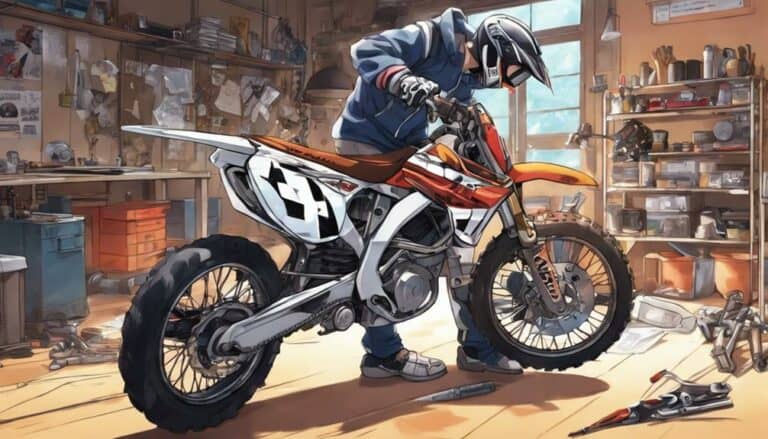So, you've seen those stunning road racers that started as humble dirt bikes, and you're curious about the transformation process.
Imagine the thrill of taking a rugged off-road machine and turning it into a sleek, high-speed road racer.
The journey from dirt to asphalt involves precise planning, mechanical finesse, and a keen eye for design.
But how exactly do you go from muddy trails to the smooth pavement, creating a machine that's both powerful and agile?
Let's uncover the secrets behind this intriguing metamorphosis.
Key Takeaways
- Prioritize engine power and weight for road racing performance
- Strip down the dirt bike to its frame for customization
- Upgrade components like suspension, tires, brakes, and engine for road racing
- Test, evaluate, and fine-tune the build for optimal performance
Choosing the Right Dirt Bike Model
When selecting a dirt bike for conversion into a road racer, prioritize the engine size, power delivery, and weight of the model. Opt for a dirt bike with a potent engine that can provide the necessary acceleration and top speed for road racing. Consider the weight of the dirt bike as lighter models are more agile and easier to handle on the track.
Look for a dirt bike known for its durability and performance. Models with a sturdy frame and adjustable suspension are ideal for road racing conversions. Make sure the chosen dirt bike has the potential for street legal modifications, such as lighting and exhaust systems, to comply with road racing regulations.
Evaluate the availability of aftermarket parts and support for the selected dirt bike model. Having easy access to replacement parts and technical assistance can make the conversion process smoother. Research the compatibility of the dirt bike's components with road racing requirements to avoid major modifications that may hinder performance. Choose a dirt bike model that's reliable, high-performing, and easy to maintain to enjoy a successful road racing conversion.
Stripping Down the Dirt Bike
To commence the process of stripping down the dirt bike for your road racer build, begin by systematically removing all non-essential components such as lights, fenders, and kickstands. This step is important in transforming your dirt bike into a lean and agile road racing machine. Follow these steps to strip down the bike effectively:
- Label and organize removed parts and hardware to ease reassembly and prevent confusion.
- Disconnect and remove the wiring harness carefully to avoid damage or issues during reinstallation.
- Strip the bike down to its frame to assess the condition and prepare for modifications and customization.
- Use proper tools and techniques to safely and efficiently disassemble the dirt bike for the road racer conversion.
Upgrading for Road Racing Performance
After stripping down the dirt bike to its frame, the next step in transforming it into a road racing machine involves upgrading various components to enhance performance on paved tracks. To boost handling, consider adjusting the suspension to optimize the bike's response to road conditions. Installing road racing tires designed for best grip and cornering stability can make a significant difference in how the bike performs on the track. Upgrading the brakes to a high-performance system will provide the stopping power needed for aggressive riding.
Engine modifications play a significant role in road racing performance. Tuning the engine for higher RPMs and improved power delivery can give you that extra edge on the straights. Adjusting the gearing ratio for a little bit more top speed and better acceleration can help you dominate the competition. Additionally, adding aerodynamic enhancements like fairings and windshields can improve stability at high speeds and reduce drag, optimizing the bike's performance on the road.
Painting and Customizing the Road Racer
For a professional and unique appearance of your road racer, customizing involves selecting a color scheme that complements the bike's design and aesthetics. When customizing your road racer, make sure to contemplate the following:
- Painting Techniques: Utilize methods like spray painting, airbrushing, or professional painting services for a high-quality finish.
- Decals and Graphics: Enhance the overall look of your road racer with decals, stickers, and graphics to add a personalized touch.
- Clear Coating: Make sure to protect your paint job from elements like UV rays, scratches, and corrosion by applying a clear coat, increasing durability.
- Custom Details: Add professional touches like pinstriping, racing numbers, or sponsor logos to give your road racer a unique and professional appearance.
Test Riding and Fine-Tuning the Build
Upon completion of the road racer build, initiating test rides and fine-tuning adjustments is essential to confirm top performance and safety.
Im going to start by test riding the road racer on various surfaces to evaluate its handling and performance. During this process, pay close attention to any unusual noises, vibrations, or handling issues that may arise. Once the initial test ride is complete, it's time to fine-tune the road racer.
Im going to adjust suspension settings to find the best balance between comfort and performance. Additionally, tweaking tire pressures and engine mapping will help guarantee the road racer operates at its best. Fine-tuning is important to harmonize all components and systems for a smooth and safe ride.
Conclusion
After meticulously selecting the right dirt bike model, stripping it down to its bare bones, upgrading for peak road racing performance, and customizing with a personal touch, it's time for the ultimate test ride.
Feel the power of the engine beneath you, hear the roar of the road beneath your tires, and experience the thrill of your very own road racer.
Fine-tune every detail, and prepare for a ride like no other.

